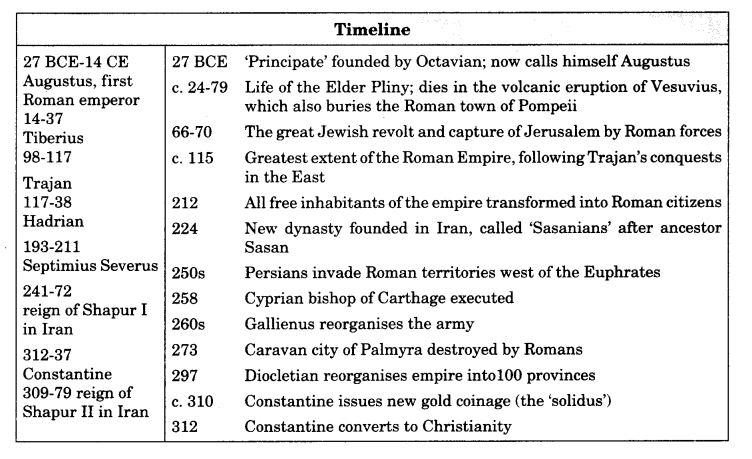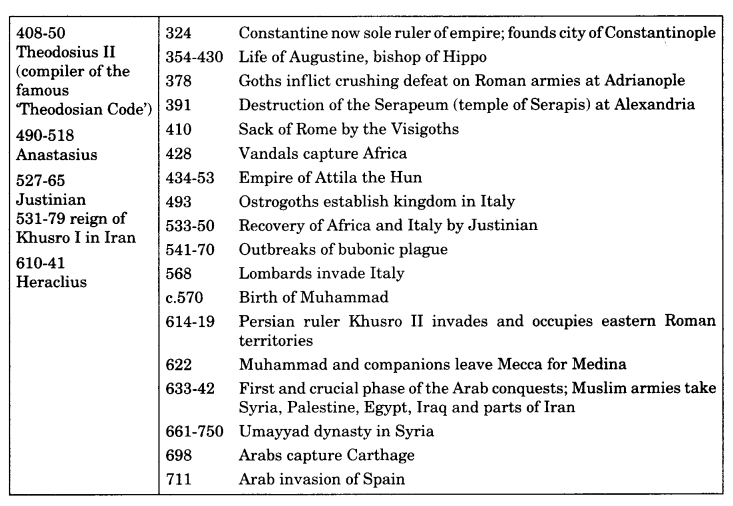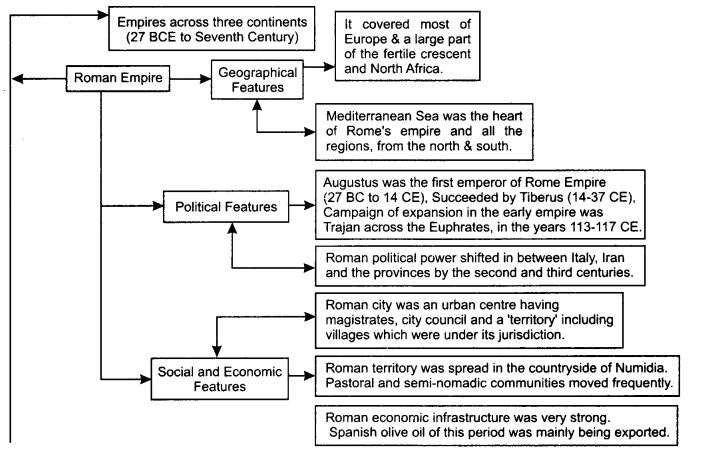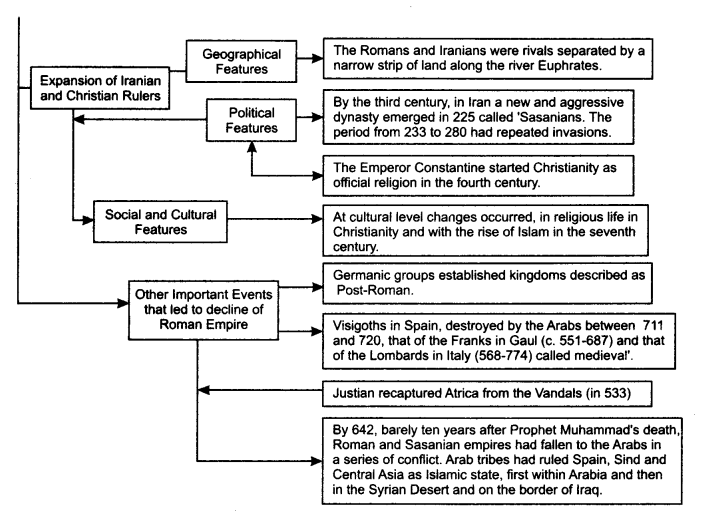Class 11 History Notes Chapter 3 An Empire Across Three Continents
- The Roman empire was spread over a vast region. It was spread into three continents— Europe, West Asia and North Africa.
- Many languages were spoken by the people of the Roman empire. Officially Latin and Greek languages were patronised by the empire.
- The political evolution of the Roman empire resembles an interesting novel, which no reader wants to leave in-between. It is divided into two parts—early empire and late antiquity.
- Roman empire was founded by Augustus who ruled from 27 BCE to 14 CE and brought to an end the chaotic condition prevailing in the Roman empire.
- During Augustus’ reign, Roman empire made unprecedented growth in the field of literature. He gave a new look to the Roman army which played an important role in expanding the Roman empire.
- The economic reforms introduced by Augusts, not only made the people of Roman empire prosperous but also helped in strengthening the very foundation of the empire.
- Augustus appointed Tiberius his successor who ruled from 14 to 37 CE.
- Trojan was a famous Roman emperor who ruled from 98 to 117 CE. He made an immense contribution in expanding the frontier of Roman empire.
- The first and the second centuries were known for a period of peace, prosperity and economic expansion but the third
- century brought the first major signs of internal strain.
- Shapur I, the Iranian ruler had eradicated the Roman army and even captured the eastern capital of Antioch.
- At the same time a whole series of Germanic tribes began to move against the Rhine and Danube frontiers, and the entire period saw repeated invasions of a whole line of provinces that stretched from the Black Sea to the Alps and Southern Germany.
- In Roman society there was system of the nuclear family. The family was used to be patriarchal in nature. The literacy rate was casual. The cultural diversity of the empire was reflected in many ways.
- There were some regional languages spoken as Aramaic in the near East, Coptic spoken in Egypt, Punic and Berber in North Africa, Celtic in Spain and the north-west.
- The empire had a significant economic infrastructure of harbours, mines, quarries, brickyards, olive oil factories, etc. Production was traded and consumed in huge quantities, and they came mainly from Spain.
- The Roman people were polytheists and used to worship several gods and goddesses. Their popular deities were Jupiter, Mars, Juno, Minerva and Isis.
- One of the most important religious sects of Roman empire was Mithraism. The otherpopular sect ‘Judaism’ was worshipped by Jehova. The Judaism considered Jehova as the creator of the universe.
- Slavery was a tradition in the Mediterranean and in the near east, as warfare became less widespread. With the establishment of peace in the first century, the supply of slaves tended to decline and the users of slave labour had to turn either to slave breeding.
- The position of the slave in the Roman empire was very miserable. They were forced to work on the estate for 10 to 18 hours a day.
- The late Roman aristocracy was extremely wealthy but not more powerful than the military leaders who came almost entirely from non-aristocratic backgrounds. The middle class was made of large mass of persons connected with grand service in the bureaucracy and also with prosperous merchants and farmers in the eastern provinces.
- The monetary system of the empire broke with the silv er-based currencies of the first three centuries. The late Roman bureaucracy, both the higher and middle echelons, was a comparatively affluent group because it drew the bulk of its salary in gold and invested much of this in buying up assets like land.
- Large expansion of Roman territory was in a less advanced state. Transhumance was spread in the countryside of Numidia. These pastoral and semi-nomadic communities were often on the move, carrying their oven-shaped huts (called mapalia). As Roman estates expanded in North Africa, the pastures of those communities were hugely reduced and their movements more tightly regulated. Even in Spain the north was much less developed, and inhabited largely by a Celtic-speaking peasantry that lived in hilltop villages called castella.
- The Emperor Constantine decided to make Christianity the official religion in the fourth century and the Emperor Diocletian (284-305) fortified the frontiers, reorganized provincial boundaries, and separated civilian from military functions, granting greater autonomy to the military commanders.
- The traditional religious culture of the classical world, both Greek and Roman, had been polytheist.
- The Visigoths in Spain was destroyed by the Arabs between 711 to 720, that of the Franks in Gaul (c.511-687) and that of the Lombards in Italy (568-774). These kingdoms foreshadowed the beginning of a different kind of world that is usually called ‘medieval’.
- Roman and Sasanian empires had fallen to the Arabs in a series of stunning confrontations. Those conquests, extended upto Spain, Sind and Central Asia, began in fact with the subjection of the Arab tribes by the emerging Islamic state.
Important terms:
- Caliphate: Islamic state led by a supreme religion
- Annals: Record of events year by year.
- Papyrus: A reed-like plant that grew along the banks of the river Nile from which paper is made.
- Mediterranean: A sea connected to the Atlantic ocean.
- Aristocracy: A form of government in which power lies in the hands of a small ruling group who are bom in a highest social class.
- Conscription: The compulsory enlistment of people in some sort of national service.
- The Euphrates:The longest and one of the most historically important rivers of Western Asia.
- Denarius: A small silver coin first minted about 211 BC.
- Barbarians: Person who is perceived to be uncivilized.
- Aramaic: The language spoken by a large group of the north-east.
- Coptic: The language spoken in Egypt.
- Punic: The language spoken in North Africa
- Berber: The language spoken in North Africa
- Celtic: The language spoken in Spain and the north-west.
- Dressel 20: A container carried the Spanish olive oil.
- Amphorae: The large storage container capacities between one-half and two and one half tons
- Draconian: Severity
- Frankincense: An aromatic resin obtained from trees of the genus Boswellia
- Echelon: A rank/position of an authority in an organisation.
- Intelligentsia: A social class of people engaged in complex mental labour aimed to spread culture and are interested in politics, literature, etc.
- Authoritarian: The authoritarian believes that people should obey his authority and rules even if he is wrong.
- Antiquity: Any period before the Middle Ages (476-1453) or ancient past.
- Archaeological: The study of cultures of the past, and the periods of history by examining the remains of buildings and objects.
- Polytheist: The worship of or belief in many Gods.
- Principate: The first period of the Roman Empire from 27 BCE – 284 CE.


Flow-Learning:

